-
RESEARCH01-01-2017
Promoting oral care in the preschool child: effects of a playful learning intervention
Revista Brasileira de Enfermagem. 2017;70(3):519-525
Abstract
RESEARCHPromoting oral care in the preschool child: effects of a playful learning intervention
Revista Brasileira de Enfermagem. 2017;70(3):519-525
DOI 10.1590/0034-7167-2016-0237
Views0See moreABSTRACT
Objective:
To compare the number of appropriate behaviors for tooth brushing before and after a playful learning intervention with preschool children.
Method:
A quasi-experimental, quantitative, before and after study design was conducted in an early childhood educational institution, with children between three and five years of age. The intervention consisted of three meetings with educational activities about tooth brushing, whose outcome was evaluated by means of observation of ten behaviors suitable for tooth brushing.
Results:
Forty-four children participated in the study. The mean of adequate behaviors was 4.4 before the intervention, and 8.5 after the intervention. A significant increase in the adoption of appropriate behaviors for tooth brushing (p <0.01) was identified.
Conclusion:
Nurses can enhance oral health promotion actions with preschoolers in preschool institution using playful learning interventions
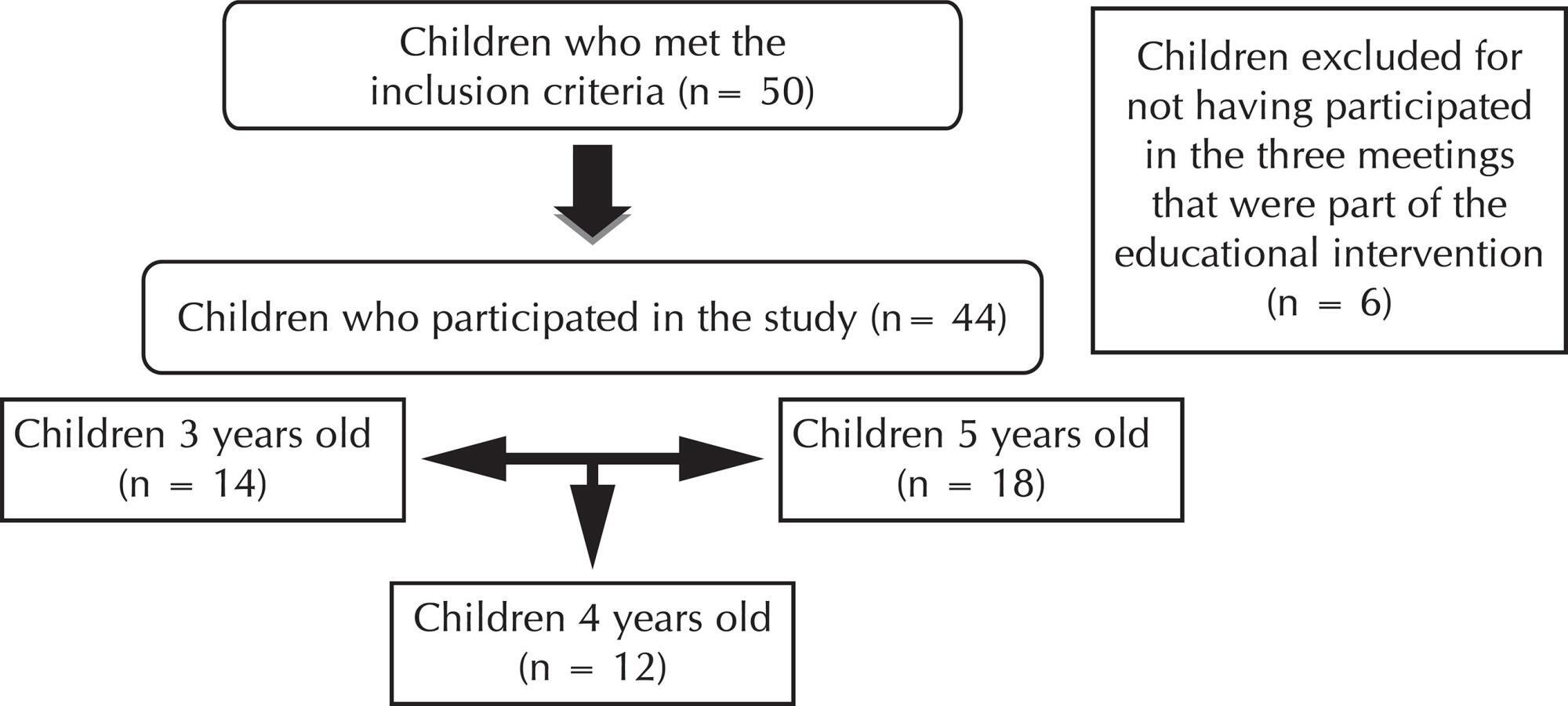
-
RESEARCH01-01-2017
Violence against children and adolescents: the perspective of Primary Health Care
Revista Brasileira de Enfermagem. 2017;70(3):511-518
Abstract
RESEARCHViolence against children and adolescents: the perspective of Primary Health Care
Revista Brasileira de Enfermagem. 2017;70(3):511-518
DOI 10.1590/0034-7167-2016-0471
Views0See moreABSTRACT
Objective:
To analyze the care provided by Basic Health Units (BHU) to families involved in domestic intrafamily violence against children and adolescents.
Method:
Qualitative research, based on the Paradigm of Complexity. Data collection was performed with 41 professionals through focus groups and semi-structured interviews.
Results:
The following categories emerged from data analysis: ‘Everything comes here’, which reflects the legitimate place of BHUs for the population and the actions taken to build care for families; and ‘We only do what is really necessary’, which brings the look to violence still based on the positivist and biomedical paradigm.
Final considerations:
The model of understanding and construction of work processes in the BHU is structured in the aforementioned paradigm. Nurses have the possibility to become agents of change, both in professionals’ training and in the care thought and provided to communities.
-
RESEARCH01-01-2017
Integrality of care: challenges for the nurse practice
Revista Brasileira de Enfermagem. 2017;70(3):504-510
Abstract
RESEARCHIntegrality of care: challenges for the nurse practice
Revista Brasileira de Enfermagem. 2017;70(3):504-510
DOI 10.1590/0034-7167-2016-0380
Views0See moreABSTRACT
Objective:
to understand the role of the nurse in the collegiate management model of a teaching hospital, in the integrality of care perspective.
Method:
a single case study with multiple units of analysis, with the theoretical proposition “integrality of care is a result of the care offered to the user by multiple professionals, including the nurse”. Data were obtained in a functional unit of a teaching hospital through interviews with 13 nurses in a non-participant observation and document analysis.
Results:
from the analytical categories emerged subcategories that allowed understanding that the nurse promotes integrality of care through nursing management, team work and integration of services.
Final considerations:
the theoretical proposition was confirmed and it was verified that the nursing management focus on attending to health care needs and is a strategy to provide integrality of care.
-
RESEARCH01-01-2017
Low completion rate of hepatitis B vaccination in female sex workers
Revista Brasileira de Enfermagem. 2017;70(3):489-494
Abstract
RESEARCHLow completion rate of hepatitis B vaccination in female sex workers
Revista Brasileira de Enfermagem. 2017;70(3):489-494
DOI 10.1590/0034-7167-2016-0567
Views0See moreABSTRACT
Objective:
to assess predictive factors for noncompletion of the hepatitis B vaccination schedule in female sex workers in the city of Teresina, Northeastern Brazil.
Method:
402 women were interviewed and, for those who did not wish to visit specialized sites, or did not know their hepatitis B vaccination status, the vaccine was offered at their workplaces. Bi- and multivariate analyses were performed to identify potential predictors for noncompletion of the vaccination schedule.
Results:
of the 284 women eligible for vaccination, 258 (90.8%) received the second dose, 157/258 (60.8%) and 68/258 (26.3%) received the second and third doses, respectively. Working at clubs and consuming illicit drugs were predictors for noncompletion of the vaccination schedule.
Conclusion:
the high acceptability of the vaccine’s first dose, associated with low completion rates of the vaccination schedule in sex workers, shows the need for more persuasive strategies that go beyond offering the vaccine at their workplaces.
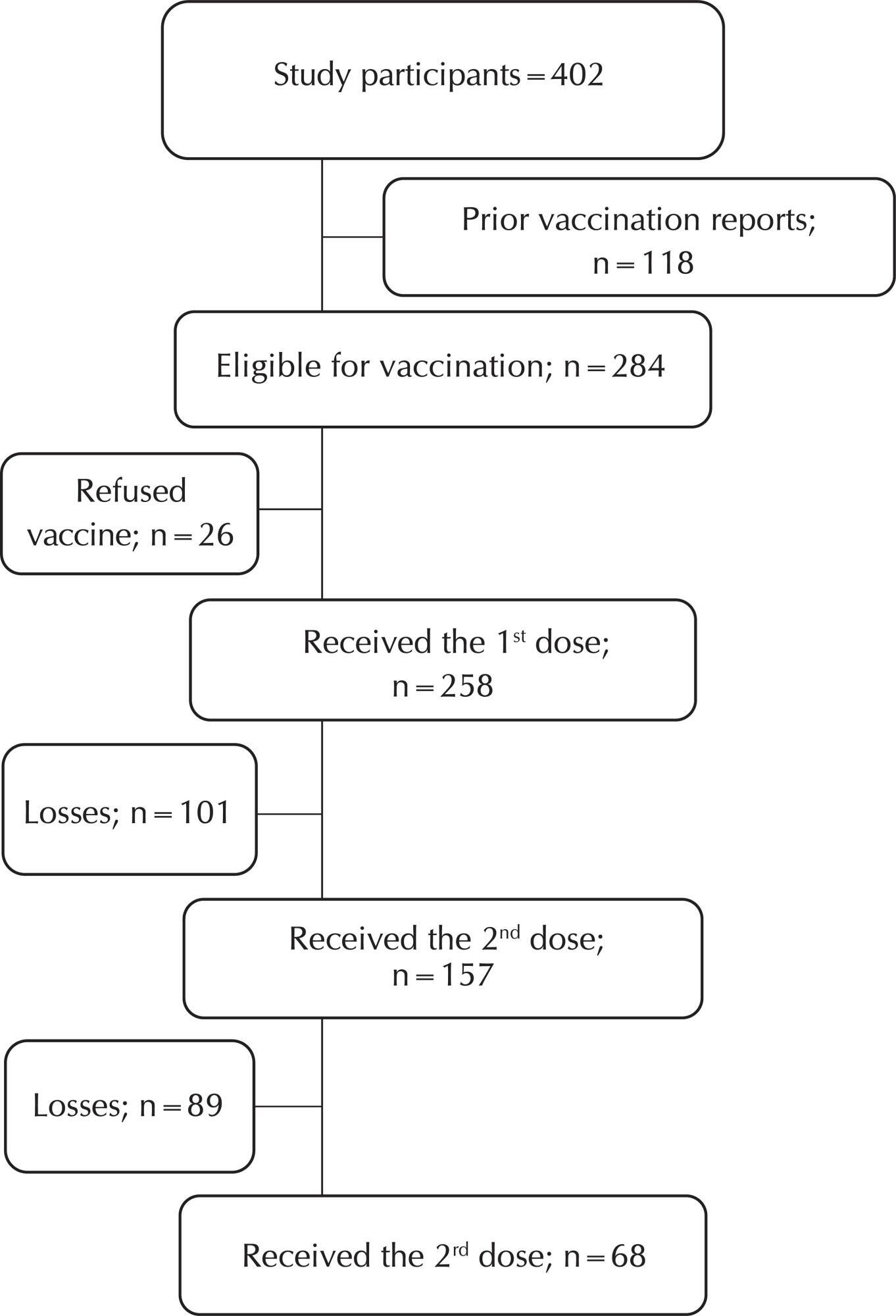
-
RESEARCH01-01-2017
Cost of nursing most frequent procedures performed on severely burned patients
Revista Brasileira de Enfermagem. 2017;70(3):481-488
Abstract
RESEARCHCost of nursing most frequent procedures performed on severely burned patients
Revista Brasileira de Enfermagem. 2017;70(3):481-488
DOI 10.1590/0034-7167-2015-0034
Views0See moreABSTRACT
Objective:
to identify the mean direct cost (MDC) of the most frequent procedures performed by nursing professionals on severely burned patients in an Intensive Care Unit.
Method:
exploratory-descriptive quantitative single-case study. The MDC was calculated by multiplying time (timed) spent by nursing professionals in the performance of the procedures by the unit cost of direct labor, and adding the costs of material and medicine/solutions.
Results:
a MDC of US$ 0.65 (SD=0.36) was obtained for “vital signs monitoring”; US$ 10.00 (SD=24.23) for “intravenous drug administration”; US$ 5.90 (SD=2.75) for “measurement of diuresis”; US$ 0.93 (SD=0.42) for “capillary blood glucose monitoring”; and US$ 99.75 (SD=129.55) for “bandaging”.
Conclusion:
the knowledge developed can support managerial decision-making, contribute to the efficiency distribution of the resources involved and, when possible, provide cost-containment or cost-minimization strategies without impairing the quality of nursing care.
-
RESEARCH01-01-2017
Nursing Activities Score and Acute Kidney Injury
Revista Brasileira de Enfermagem. 2017;70(3):475-480
Abstract
RESEARCHNursing Activities Score and Acute Kidney Injury
Revista Brasileira de Enfermagem. 2017;70(3):475-480
DOI 10.1590/0034-7167-2016-0266
Views0See moreABSTRACT
Objective:
to evaluate the nursing workload in intensive care patients with acute kidney injury (AKI).
Method:
A quantitative study, conducted in an intensive care unit, from April to August of 2015. The Nursing Activities Score (NAS) and Kidney Disease Improving Global Outcomes (KDIGO) were used to measure nursing workload and to classify the stage of AKI, respectively.
Results:
A total of 190 patients were included. Patients who developed AKI (44.2%) had higher NAS when compared to those without AKI (43.7% vs 40.7%), p <0.001. Patients with stage 1, 2 and 3 AKI showed higher NAS than those without AKI. A relationship was identified between stage 2 and 3 with those without AKI (p = 0.002 and p <0.001).
Conclusion:
The NAS was associated with the presence of AKI, the score increased with the progression of the stages, and it was associated with AKI, stage 2 and 3.
-
RESEARCH01-01-2017
Nursing appointment and cardiometabolic control of diabetics: a randomized clinical trial
Revista Brasileira de Enfermagem. 2017;70(3):468-474
Abstract
RESEARCHNursing appointment and cardiometabolic control of diabetics: a randomized clinical trial
Revista Brasileira de Enfermagem. 2017;70(3):468-474
DOI 10.1590/0034-7167-2016-0352
Views0See moreABSTRACT
Objective:
to verify the effect of nursing appointment on cardiometabolic profile of people with Diabetes Mellitus type 2.
Method:
randomized controlled trial, developed with 134 individuals chosen for two groups: intervention and control. The intervention consisted of three nursing appointments alternated bimonthly, with two phone calls, over five months. The control group received usual care offered by the Health Unit. Data were collected through semi-structured interviews before and after the intervention, in addition to conducting laboratory tests.
Results:
after the intervention, a significant difference was shown in the amount of glycated hemoglobin (p = 0.006) and in the systolic blood pressure (p = 0.031), which were higher in the control group.
Conclusion:
besides being low-cost and easy to develop on the monitoring routine of people with diabetes, the intervention performed influenced positively the biochemical profile.
-
RESEARCH01-01-2017
Terms of the specialized nursing language for the care of ostomates
Revista Brasileira de Enfermagem. 2017;70(3):461-467
Abstract
RESEARCHTerms of the specialized nursing language for the care of ostomates
Revista Brasileira de Enfermagem. 2017;70(3):461-467
DOI 10.1590/0034-7167-2015-0058
Views0See moreABSTRACT
Objectives:
to identify terms of the specialized nursing language for the care of ostomates from the literature of the area, and to map the identified terms with terms of the International Classification for Nursing Practice (ICNP®).
Method:
descriptive study of quantitative approach guided by the guidelines for the elaboration of terminology subsets of the ICNP®. The terms were collected in 49 scientific articles, extracted using a computational tool, selected according to the relevance for the theme, and normalized and mapped with the ICNP®.
Results:
20,668 terms were extracted. The standardization process resulted in 425 relevant terms (151 were constant in ICNP® and 274 were not contained in ICNP®), of which 154 were similar, 19 were more comprehensive, 50 were more restricted, and 51 were not in concordance.
Conclusion:
the use of standardized language can minimize the ambiguities and redundancies identified in the mapping. The existence of terms not in concordance with the ICNP® reinforces the need for constant updating of this classification.
-
ORIGINAL ARTICLE12-08-2023
Simulation-based training in Leprosy: development and validation of a scenario for community health workers
Revista Brasileira de Enfermagem. 2023;76:e20230114
Abstract
ORIGINAL ARTICLESimulation-based training in Leprosy: development and validation of a scenario for community health workers
Revista Brasileira de Enfermagem. 2023;76:e20230114
DOI 10.1590/0034-7167-2023-0114
Views0See moreABSTRACT
Objectives:
To build and validate a clinical simulation scenario designed to instruct community health workers (CHWs) in active leprosy case detection.
Methods:
Methodological study involving the development of a simulated clinical scenario and content validation by experts. The Content Validity Index (CVI) was used to determine the level of agreement among the judging commitee, and a descriptive analysis of their recommendations was performed.
Results:
A simulated scenario with a simulated participant was developed — a simulation characterized by low complexity, moderate physical/environmental fidelity, moderate to high psychological fidelity, and high conceptual fidelity, lasting 50 minutes and capable of training up to 10 CHWs simultaneously. The scenario was validated by 14 experts, with a CVI exceeding 80% for all components.
Conclusions:
The validated clinical simulation possesses attributes that make it highly reproducible in various national health contexts, thereby contributing to the global “Towards Zero Leprosy” strategy.
-
ORIGINAL ARTICLE12-08-2023
Knowledge and practices about health among Quilombola men: contributions to health care
Revista Brasileira de Enfermagem. 2023;76:e20230138
Abstract
ORIGINAL ARTICLEKnowledge and practices about health among Quilombola men: contributions to health care
Revista Brasileira de Enfermagem. 2023;76:e20230138
DOI 10.1590/0034-7167-2023-0138
Views1See moreABSTRACT
Objective:
to analyze health knowledge and practices among Quilombola men.
Methods:
a qualitative, descriptive study, carried out with 40 men from two Quilombola communities in Santa Izabel do Pará, state of Pará, Brazil. Individual interviews were carried out using a semi-structured script. Text corpus was subjected to analysis with Interface de R pour les Analyses Multidimensionnelles de Textes et de Questionnaires 0.6, alpha 3, through Descending Hierarchical Classification.
Results:
among participants, eight (20.00%) were aged 55 to 59 years. 382 text segments were identified, with 299 (78.27%) being used, generating five lexical classes, which made up two subcorpora. The classes were organized into four thematic axes, covering knowledge about health and practices to prevent and solve health problems.
Final considerations:
men highlighted popular/traditional wisdom permeated by biomedical knowledge, translating their understanding of how to act to remain or become healthy.
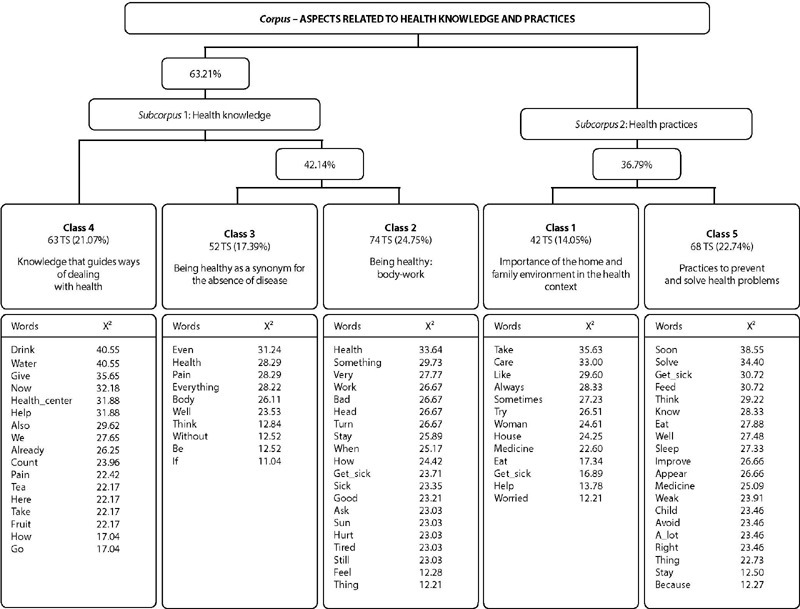
-
ORIGINAL ARTICLE10-06-2023
Ethical problems in nursing teleconsultations for people living with HIV during the Covid-19 pandemic
Revista Brasileira de Enfermagem. 2023;76:e20220754
Abstract
ORIGINAL ARTICLEEthical problems in nursing teleconsultations for people living with HIV during the Covid-19 pandemic
Revista Brasileira de Enfermagem. 2023;76:e20220754
DOI 10.1590/0034-7167-2022-0754
Views0See moreABSTRACT
Objectives:
to understand the ethical problems experienced by primary health care nurses in using nursing teleconsultations for people living with the human immunodeficiency virus during the coronavirus pandemic.
Methods:
qualitative research, anchored in Constructivist Grounded Theory. Data was collected between July and September 2020, with 17 participants.
Results:
the first category highlights the ethical problems in conducting teleconsultations, managing high demand, communication barriers, and risks related to data security. The second emphasizes the potential of teleconsultations in communication and access, by generating changes in the work process and the use of protocols to guide clinical practice.
Conclusions:
nurses’ work in digital mode requires professional qualification, with a view to stimulating reflection on teleconsultation practice, ethical-moral deliberation and combating stigma, and also adopting data security-centered conduct.
-
12-04-2023
Ethical dilemmas at the end of life: a reflection from the Philosophical Perspective of Luigina Mortari
Revista Brasileira de Enfermagem. 2023;76:e20220759
Abstract
Ethical dilemmas at the end of life: a reflection from the Philosophical Perspective of Luigina Mortari
Revista Brasileira de Enfermagem. 2023;76:e20220759
DOI 10.1590/0034-7167-2022-0759
Views0See moreABSTRACT
Objectives:
to reflect on the ethical dilemmas involved in the care of patients at the end of their lives.
Methods:
this is a theoretical-reflective study based on the ethics of care proposed by Luigina Mortari.
Results:
discussing care involves addressing the ways of being inherent to human existence and understanding the unique characteristics of this condition. Ethical care constitutes an action driven by interest in the other and by the perception of their need. Ethical dilemmas are a part of end-of-life care, making it essential to maintain respectful assistance that considers the patient’s autonomy, using strategies for expressing their wishes, and ensuring continuous clear and empathetic communication among all those involved in providing care.
Final Considerations:
issues related to being, stemming from one’s reality of dependency and vulnerability, contribute to the emergence of ethical dilemmas present in care actions.
-
ORIGINAL ARTICLE12-04-2023
Overview of nursing ethics teaching in Brazilian public higher education institutions
Revista Brasileira de Enfermagem. 2023;76:e20220808
Abstract
ORIGINAL ARTICLEOverview of nursing ethics teaching in Brazilian public higher education institutions
Revista Brasileira de Enfermagem. 2023;76:e20220808
DOI 10.1590/0034-7167-2022-0808
Views0See moreABSTRACT
Objectives:
to outline the teaching of ethics in undergraduate Nursing programs in Brazilian public higher education institutions.
Methods:
descriptive and exploratory study, carried out through the documentary analysis of pedagogical projects of undergraduate Nursing programs in Brazil.
Results:
153 active undergraduate Nursing programs were found, of which 106 provide the pedagogical project. In addition to deontological teaching, the teaching of ethics was identified in a transversal way associated with themes such as Social Context, Hospital and Community Care, Pharmacology, Systematization of Nursing Care, Surgical Nursing, Epidemiology, Palliative Care, Management in Nursing, Diversity, Women’s, Children’s, Adolescent’s, Adult’s and Older People’s Health, and Mental Health.
Final Considerations:
the challenge in teaching nursing ethics is its integration with each action of caring, teaching and managing.
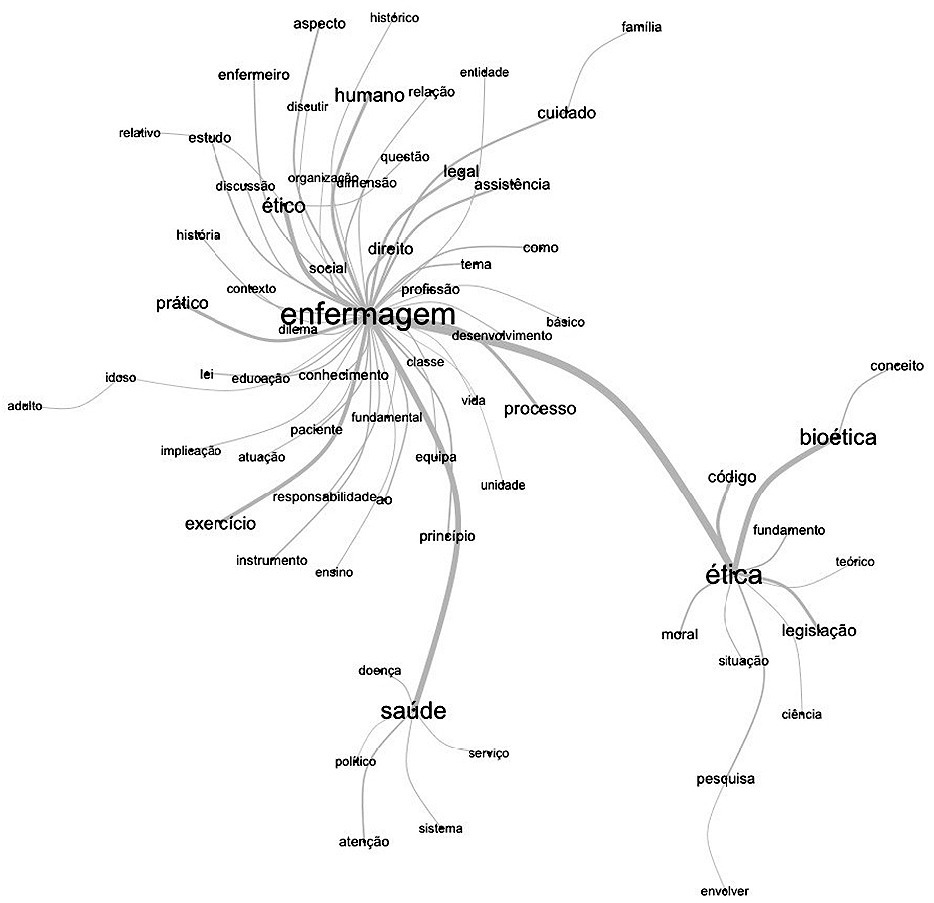
-
ORIGINAL ARTICLE12-08-2023
Validation of telesimulation in the care of late preterm newborns with hypoglycemia for nursing students
Revista Brasileira de Enfermagem. 2023;76:20220438
Abstract
ORIGINAL ARTICLEValidation of telesimulation in the care of late preterm newborns with hypoglycemia for nursing students
Revista Brasileira de Enfermagem. 2023;76:20220438
DOI 10.1590/0034-7167-2022-0438
Views0See moreABSTRACT
Objective:
To develop and validate a telesimulation scenario for nursing students in the care of late preterm infants with hypoglycemia.
Methods:
A methodological study conducted between August 2021 and May 2022 in a virtual environment involved constructing and validating the scenario with 10 experts, and testing it with 10 students. The content validity index assessed validity, with a threshold of 80% or higher, and suggestions were analyzed using semantic approximation.
Results:
Validation confirmed the appropriateness of all 14 scenario items, with an overall index of 97.8% and clarity and relevance indices of 98.5%. During testing, the overall index was 99.7%, with the “resources” item receiving the lowest score. Adjustments were made to objectives, technical terms, resources, and target audience based on feedback.
Conclusion:
Telesimulation is a widely accepted educational technology for training nursing students, with potential to enhance teaching quality and neonatal care.
-
ORIGINAL ARTICLE11-10-2023
Construction and validity of educational technology in audiovisual media on premature newborn care
Revista Brasileira de Enfermagem. 2023;76:e20220403
Abstract
ORIGINAL ARTICLEConstruction and validity of educational technology in audiovisual media on premature newborn care
Revista Brasileira de Enfermagem. 2023;76:e20220403
DOI 10.1590/0034-7167-2022-0403
Views0See moreABSTRACT
Objectives:
to construct and validate an educational video storyboard about care for premature newborns at home.
Methods:
a methodological study, with the construction of an educational video storyboard, validated with 14 judges. Content was selected from scoping review. For data collection, a validated instrument was used. The criterion for validity was agreement greater than 80%, analyzed using the Content Validity Index.
Results:
the storyboard construction was guided by the Cognitive Theory of Multimedia Learning theoretical framework. Construction and validity took place from May to December 2020. The storyboard’s final version lasted 10 minutes, and was validated in terms of objective, structure, presentation and relevance, with a Content Validity Index of 0.9.
Conclusions:
the storyboard of the educational video proved to be valid and adequate for health promotion in developing care for premature newborns at home.

-
ORIGINAL ARTICLE12-08-2023
Early ambulation and dhikr complementary therapies effect on intestinal peristaltic in post-open cholecystectomy patients
Revista Brasileira de Enfermagem. 2023;76:e20220636
Abstract
ORIGINAL ARTICLEEarly ambulation and dhikr complementary therapies effect on intestinal peristaltic in post-open cholecystectomy patients
Revista Brasileira de Enfermagem. 2023;76:e20220636
DOI 10.1590/0034-7167-2022-0636
Views0ABSTRACT
Objectives:
to analyze and determine the effect of a combination intervention of early ambulation and dhikr therapy on intestinal peristaltic recovery in post-open cholecystectomy patients.
Methods:
a pre-experimental design with one group pre and post-test design was used. The samples were 15 post-open cholecystectomy patients which were selected using the purposive sampling technique. The data were collected using the instrument observation sheet and analyzed using the Wilcoxon test. Early ambulation used standard operational procedure in the hospital and dhikr therapy was carried out at 2 hours post-operation for 10-15 minutes.
Results:
there was an effect of early ambulation and dhikr therapy on intestinal peristaltic recovery in post-open cholecystectomy patients with general anesthesia (Z=-3.442; p=0.001).
Conclusions:
a combination of early ambulation and dhikr therapy can be recommended as interventions to improve intestinal peristaltic in a post-open cholecystectomy patient with general anesthesia.
Keywords:Anesthesia, GeneralCholecystectomyComplementary TherapiesEarly AmbulationPerioperative NursingSee more
-
ORIGINAL ARTICLE07-18-2022
Cultural adaptation and content validity evidence of the Nutritional Literacy Scale Brazilian version
Revista Brasileira de Enfermagem. 2022;75(6):e20210657
Abstract
ORIGINAL ARTICLECultural adaptation and content validity evidence of the Nutritional Literacy Scale Brazilian version
Revista Brasileira de Enfermagem. 2022;75(6):e20210657
DOI 10.1590/0034-7167-2021-0657
Views0See moreABSTRACT
Objective:
To investigate the evidence of content validity and reliability of the Brazilian version of the Nutritional Literacy Scale (NLS) after the cultural adaptation process.
Methods:
Psychometric study of 1,197 users of the National Health Service (Brazilian SUS). The NLS was culturally adapted to Brazilian Portuguese and six items of the original scale were modified to improve its understanding, giving rise to the Brazilian version of the scale named NLS-BR. The analysis of evidence of content validity of the NLS-BR was performed using the Item Response Theory (IRT).
Results:
The final version of the NLS-BR had 23 items and proved to be adequate to assess nutritional literacy in adults assisted by the Brazilian SUS.
Final considerations:
The NLS-BR proved to be of adequate understanding and demonstrated evidence of content validity and reliability for users of the Brazilian SUS.
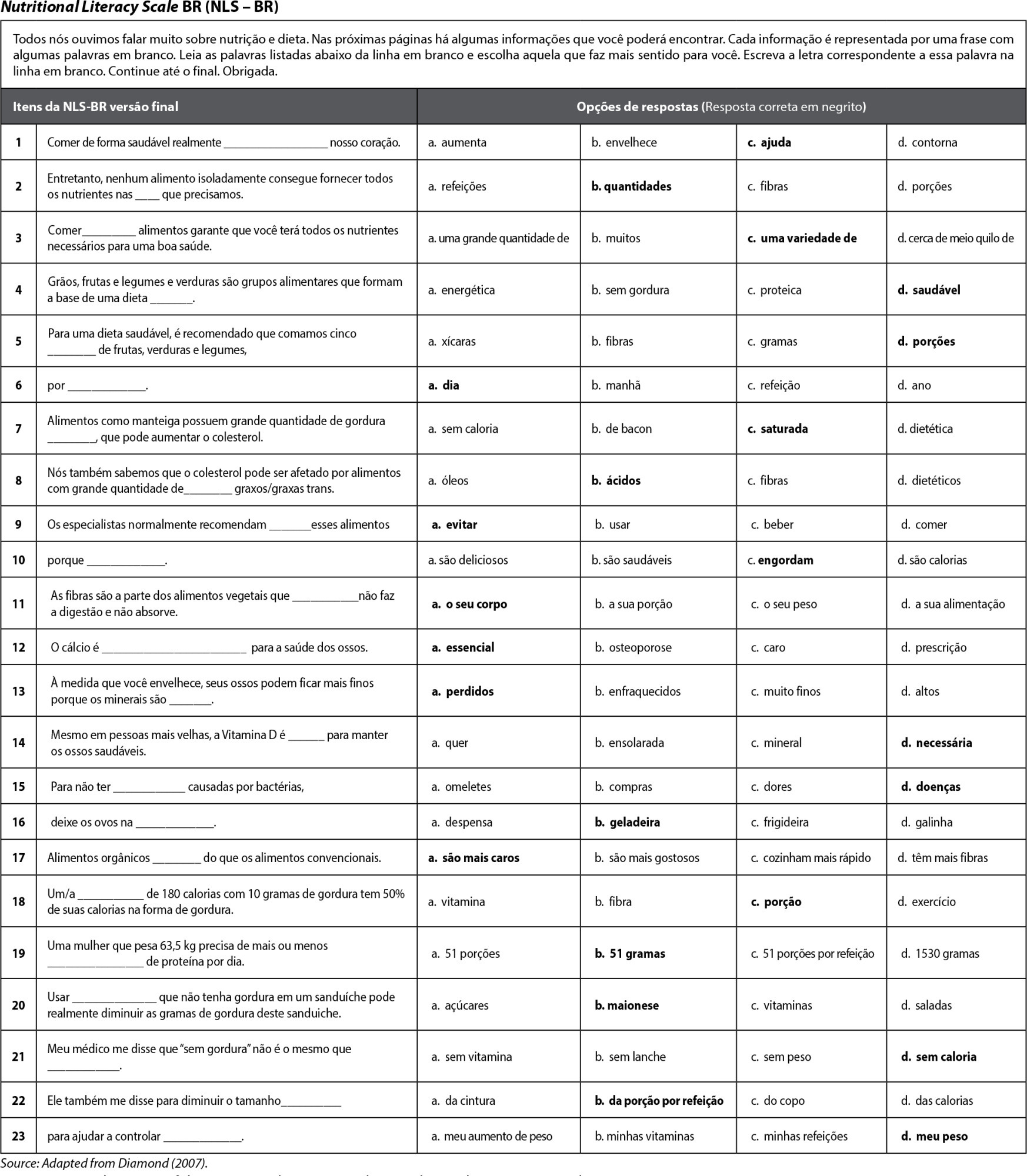
-
ORIGINAL ARTICLE10-26-2020
Suspected COVID-19 flu-like syndrome in men who have sex with men and have been involved in casual sex
Revista Brasileira de Enfermagem. 2020;73:e20200913
Abstract
ORIGINAL ARTICLESuspected COVID-19 flu-like syndrome in men who have sex with men and have been involved in casual sex
Revista Brasileira de Enfermagem. 2020;73:e20200913
DOI 10.1590/0034-7167-2020-0913
Views0See moreABSTRACT
Objective:
To evaluate the presence of flu-like syndrome suggestive of COVID-19 in men who have sex with men (MSM) and engaged in casual sex during a period of social isolation.
Method:
National epidemiological survey, applied in April and May 2020, by adaptation of Respondent Drive Sampling.
Results:
1,337 MSM participated in the survey, of which 514 (38.4%) had fever associated with another sign or symptom of flu-like syndrome. Social, demographic characteristics, sexual practices and activities during the period of social isolation were statistically associated with the presence of flu-like syndrome. There was a statistical difference (p < 0.001) in the average of partners between those who had signs and symptoms of flu-like syndrome (3.5) and those who did not (1.7).
Conclusion:
Evidence of signs and symptoms indicative of flu-like syndrome suggestive of COVID 19 in Brazilian MSM who were involved in casual sex during the period of social isolation.

-
ORIGINAL ARTICLE07-31-2020
Sexuality and associated risk factors in pregnant women
Revista Brasileira de Enfermagem. 2020;73:e20180786
Abstract
ORIGINAL ARTICLESexuality and associated risk factors in pregnant women
Revista Brasileira de Enfermagem. 2020;73:e20180786
DOI 10.1590/0034-7167-2018-0786
Views0See moreABSTRACT
Objectives:
to assess the sexual function of pregnant women and the influence of sociodemographic, obstetric, and behavioral factors on sexual dysfunction.
Methods:
cross-sectional study conducted with 141 pregnant women attended by the Single Health System and 120 by one private service, totaling 261 participants. A questionnaire containing sociodemographic, obstetric, and behavioral variables was applied, as well as the Female Sexual Function Index instrument, which was used to assess sexual function. Associations between variables and sexual dysfunction were made using the chi-square test, considering a statistically significant result when p < 0.05.
Results:
among the participants, 32.1% had sexual dysfunction, and the variables “age”, “income” and “type of health service” had an influence on sexual dysfunction. The prevalence of pregnant women was between 21 and 30 years old (p < 0.001), with an income between 1 and 2 minimum wages (p = 0.048) and used the public health system network (p = 0.000).
Conclusions:
the factors associated with sexual dysfunction are “young pregnant women”, “low income” and “attended in the public health service”.
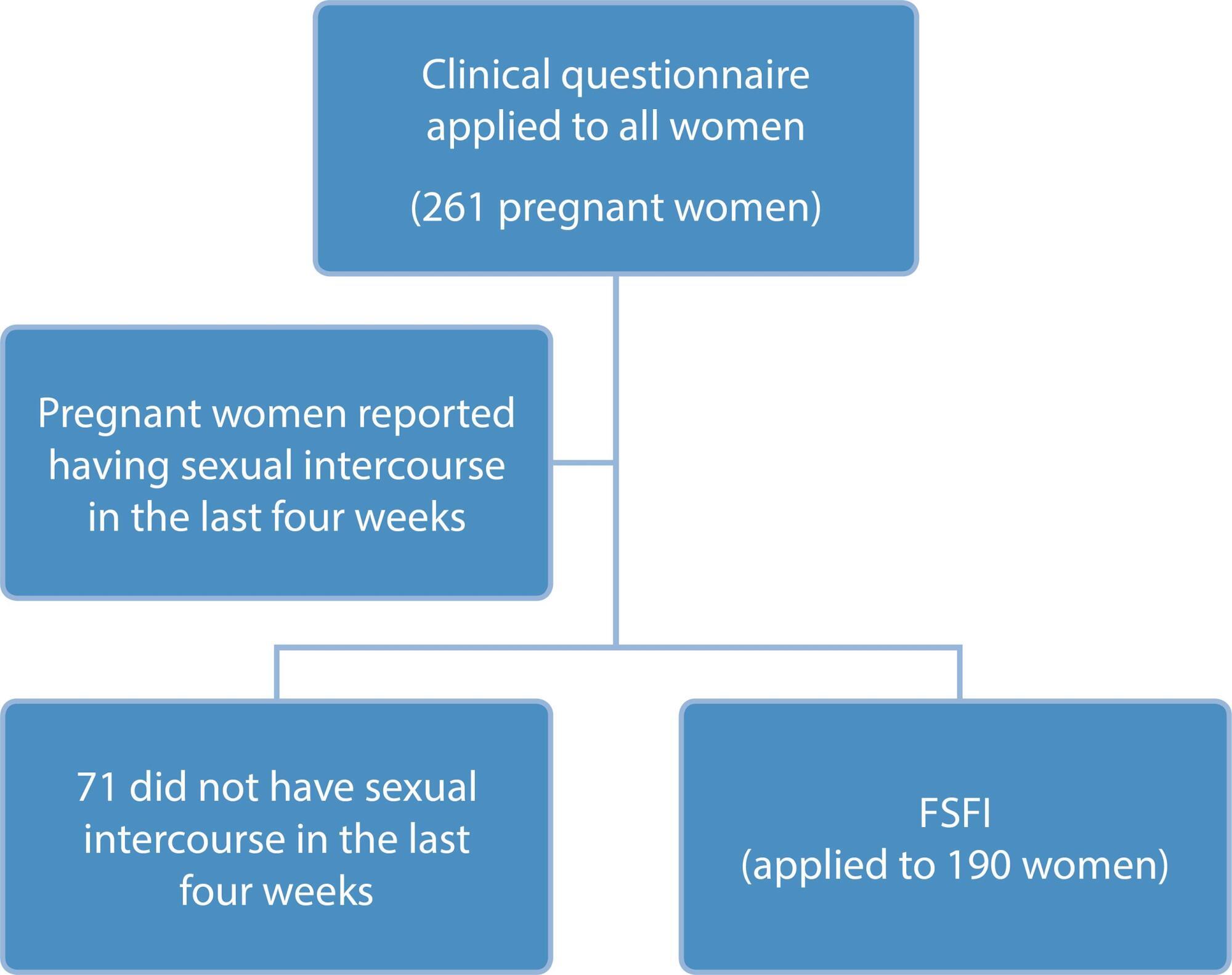
-
ORIGINAL ARTICLE02-10-2020
Healthcare professionals’ perception of mental health in primary care
Revista Brasileira de Enfermagem. 2020;73(1):e20180201
Abstract
ORIGINAL ARTICLEHealthcare professionals’ perception of mental health in primary care
Revista Brasileira de Enfermagem. 2020;73(1):e20180201
DOI 10.1590/0034-7167-2018-02011
Views0See moreABSTRACT
Objective:
To characterize the mental health care provided in Primary Care from the perception of health professionals in the cities to the 5th Regional Health Center of the state of Paraná.
Method:
An exploratory qualitative research. Participants were 121 health professionals working in primary care in the 20 cities of 5th Regional Health Center of the state of Parana. Twenty-two focus groups were recorded, transcribed and analyzed by content analysis.
Results:
Five thematic categories emerged, of which two were analyzed in this study: actions that professionals consider to be mental health actions; mental health actions developed by Primary Care professionals.
Final Considerations:
Despite of the indications of inclusion of mental health actions in Primary Care, this relationship is still occasional and unplanned. Policies that foster this interaction from a psychosocial perspective are needed.
-
REFLECTION10-26-2020
New coronavirus: what does nursing have to learn and teach in times of a pandemic?
Revista Brasileira de Enfermagem. 2020;73:e20200259
Abstract
REFLECTIONNew coronavirus: what does nursing have to learn and teach in times of a pandemic?
Revista Brasileira de Enfermagem. 2020;73:e20200259
DOI 10.1590/0034-7167-2020-0259
Views0See moreABSTRACT
Objective:
To promote a theoretical reflective analysis of what nursing has to learn and teach to global society in times of OVID-19 pandemic.
Methods:
Reflective theoretical essay aimed at contributing new knowledge and raising new questions, based on the assumptions of Edgar Morin’s complexity thinking, subsidized by readings of texts extracted from electronic databases, as well as speeches by health professionals available in open communication tools.
Results:
COVID-19 reiterates that the biological warfare of the current pandemic is not fought with nuclear or fire weapons, but with care in its multiple dimensions: physical, emotional, spiritual, family, social, political and economic.
Final considerations:
Nursing has to learn and teach global society that its main object of work, care, is related to the expansion of systemic interactions and associations and the capacity to strengthen the interlocution with complex reality.
-
REVIEW02-10-2020
Low Chronic Self-Esteem and Low Situational Self-Esteem: a literature review
Revista Brasileira de Enfermagem. 2020;73(1):e20180004
Abstract
REVIEWLow Chronic Self-Esteem and Low Situational Self-Esteem: a literature review
Revista Brasileira de Enfermagem. 2020;73(1):e20180004
DOI 10.1590/0034-7167-2018-0004
Views0See moreABSTRACT
Objective:
to develop a literature review about low self-esteem and components of the nursing diagnoses Low Chronic Self-Esteem and Low Situational Self-Esteem in patients with depressed mood.
Method:
an integrative literature review carried out in the Pubmed portal and in the Scopus and Web of Science electronic bibliographic databases. Depression and self-esteem descriptors were used, resulting in 32 articles.
Results:
literature indicated 7 clinical indicators and 14 etiological factors for low self-esteem.
Conclusion:
The clinical indicators Suicidal ideation and Ineffective treatment were more prevalent in the study. The etiological factors Stressful events and Stigmatization were the most frequent, both of which were suggested as new related factors for low self-esteem. Nursing diagnosis recognition can contribute to intervention strategy elaboration by the nurse, according to the urgent diagnostic and the individual’s particularities.
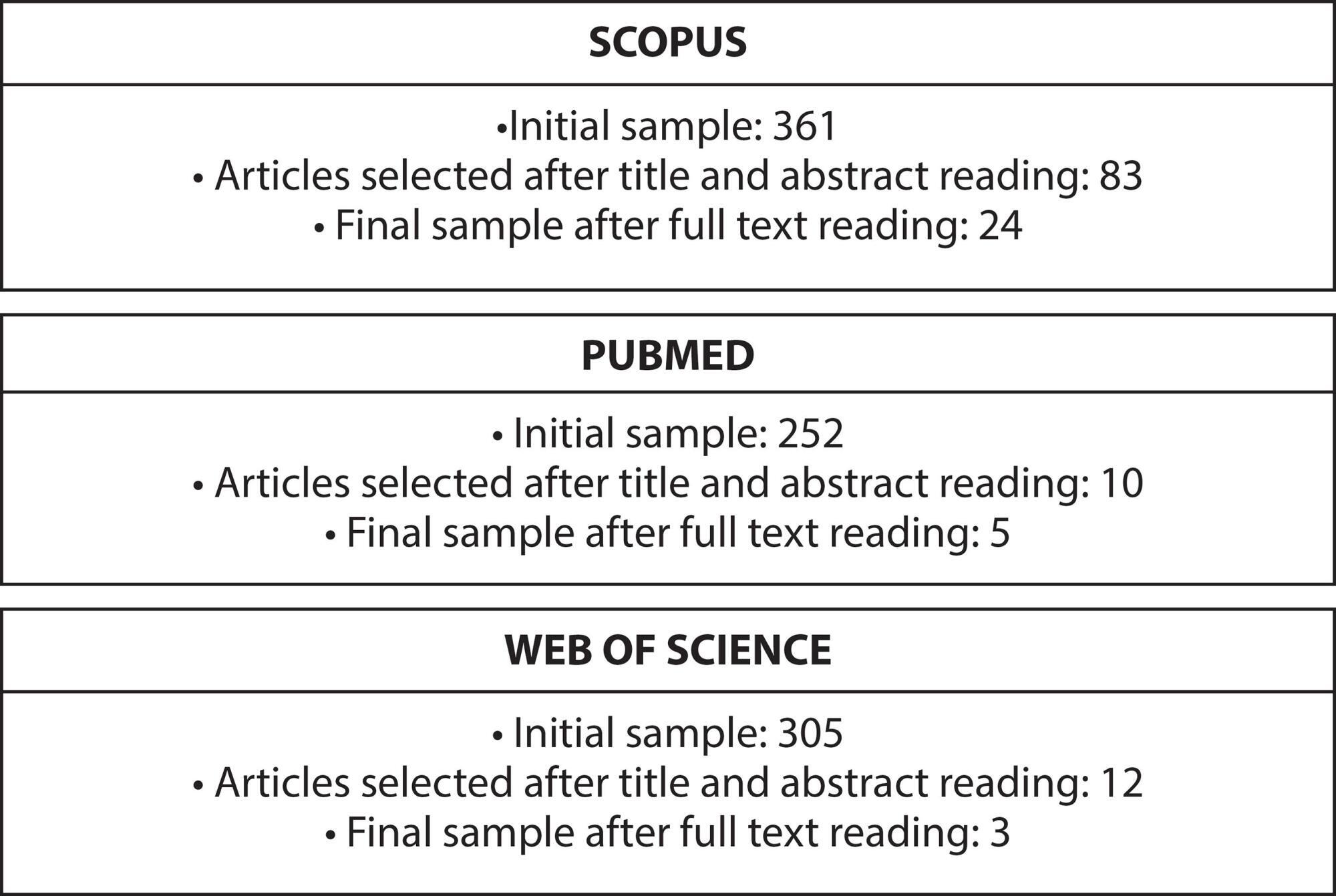
-
ORIGINAL ARTICLE07-31-2020
Social and obstetric inequalities and vaccination in pregnant women
Revista Brasileira de Enfermagem. 2020;73:e20190099
Abstract
ORIGINAL ARTICLESocial and obstetric inequalities and vaccination in pregnant women
Revista Brasileira de Enfermagem. 2020;73:e20190099
DOI 10.1590/0034-7167-2019-0099
Views0See moreABSTRACT
Objectives:
to analyze the association of socioeconomic level and obstetric characteristics with vaccine registration of pregnant women.
Methods:
cross-sectional study, performed with 480 women in puerperal. Vaccination of pregnant women was considered a dependent variable and as independent variables were age, skin color, education, steady union, paid work, and number of prenatal consultations. Association between variables was verified by the Poisson’s regression model.
Results:
from 480 pregnant women’s health cards, 10.63% had information on hepatitis B vaccination; 31.46% for tetanus; and 90% of the health cards had not register for influenza. There was an association of paid work and number of prenatal consultations with hepatitis B vaccination.
Conclusions:
lower percentages in absence of vaccination occurred in women who were in the job market and had a higher number of prenatal consultations. This suggests that socioeconomic inequalities may interfere with the vaccination of pregnant women in health services.
-
ORIGINAL ARTICLE08-30-2021
Mental health in adolescence: Elaboration and validation of an educational technology for health promotion
Revista Brasileira de Enfermagem. 2021;74(5):e20201023
Abstract
ORIGINAL ARTICLEMental health in adolescence: Elaboration and validation of an educational technology for health promotion
Revista Brasileira de Enfermagem. 2021;74(5):e20201023
DOI 10.1590/0034-7167-2020-1023
Views1See moreABSTRACT
Objective:
to build and validate the appearance of a digital educational technology to promote the mental health of school adolescents.
Methods:
methodological study, which included the elaboration and validation of the “Conect@dos com a S@ude” online course based on the Galvis-Panqueva methodological framework. The elaboration was based on a literature review and followed the Theory of Meaningful Learning. The validation was performed by a total of 21 adolescent students, using an instrument adapted for the study. A quantitative analysis was performed from the Content Validity Index and descriptive of the suggestions pointed out by the target audience.
Results:
the analysis of the Content Validity index ranged from 0.8 to 1 in all evaluated items. The adolescents presented some suggestions for improvement for the course, most of them were accepted.
Conclusion:
the course was validated by the target audience.

Search
Search in:
Nuvem de Tags
Adolescente (85) Atenção Primária à Saúde (239) COVID-19 (91) Criança (91) Cuidados de Enfermagem (269) Educação em Enfermagem (151) Educação em Saúde (139) Enfermagem (930) Enfermagem Pediátrica (86) Estudantes de Enfermagem (77) Estudos de Validação (131) Família (87) Idoso (208) Promoção da Saúde (99) Qualidade de Vida (104) Saúde do Trabalhador (86) Saúde Mental (145) Saúde Pública (82) Segurança do Paciente (150) Tecnologia Educacional (100)



